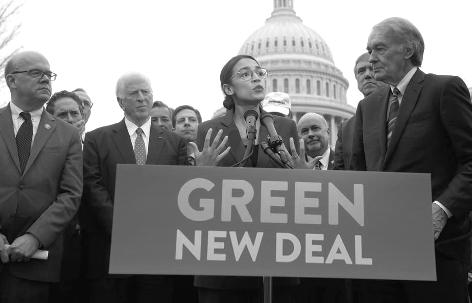
10 minute read
In Discussion with Billy Fleming
from No.12 CARE
by DATUM
20
A DISCUSSION WITH BILLY FLEMING DESIGN AND THE GREEN NEW DEAL
Advertisement
BILLY FLEMING
Datum had the opportunity to contribute to a panel discussion with Billy Fleming along with NOMAS ISU chapter, and some ISU Department of Architecture faculty members, after his lecture on Design and the Green New Deal. This is a transcription from the panel discussion 2.28.20.
Datum: In your lecture and your essay on “Design and the Green New Deal”, you mention that since the Green New Deal is a good opportunity for designers to participate in addressing the climate crisis and become practitioners of care. One of the questions that came around in our discussion was, if at all, do you find the green new deal insufficient in any way, and if so how? And what is the best way to communicate this in order for us as designers to engage in the practice of caring for the ecosystem?
Billy Fleming: Yeah, that is a great question. There are all kinds of ways in which I think the Green New Deal is insufficient or at least there are things about it that worry me. The two big ones are that The Green New Deal, HR109 and every other document within GND-world that you can find, have nothing to say about international affairs and foreign policy. And yet, all of the technology that is higher explicitly or implicitly called out in HR 109—PVs, electric cars, turbines, etc.—that are supposed to be part of electrifying everything in our lives through clean energy, require various minerals and all kinds of other materials that must be mined or extracted from places that we [the US and Global North] have a very long history of treating like Shit! All we do is extract things from them and transfer wealth to ourselves. And when I ask this question within the broader GND-world that I work, I’m always told “oh yes that’s a big problem, but someone else will take care of that.” And so, I remain very nervous that the Green New Deal will become coopted as a weapon for a form of green imperialism...
I also worry about its eco-modernist orientation—operating from the position that technology is going to solve most of the climate crisis for us. And I just think, in many ways, this view is hopelessly naive. Technology is NOT going to solve the problems at the core of the Green New Deal for us. And in fact, technology can and probably will make much of this worse, at least in the short-term. This is also where you start to see people leaning into discussions or ideas about geoengineering, as potential solutions to the problem of planetary climate
change. The meme version of this is something like “you can just turn down the sun,” but it is a bit more complicated than that—even if some conceptions of geoengineering are doing exactly that. Many of these approaches require us to ignore or set aside all the uncertainty surrounding geoengineering, things like the rapid rate of acidification in our oceans. You don’t have to look deep into the scientific literature to see that we are probably heading towards a world, perhaps beyond most of our lifetimes but not by much, in which there are no functioning fisheries left on the planet. , Geoengineering is not going to help with that—or any other question beyond regulating temperature—and the more it’s studied the more it seems it will make all of these other issues worse. So these are the things that worry me the most: the tilt towards eco-modernism, the tilt towards green new imperialism, and I also just worry in general, there are a lot of smart people on the right who recognize that climate change is something they cannot ignore forever, and that they will find ways to outflank us and peel people away behind some kind of nationalist, blood and soil climate program. Some of them are already imagining what an eco-fascist program and alternative to the Green New Deal could look like. Jair Bolsonaro, Brazil’s autocratic President who’s been leading a genocidal regime, and Bjarke Ingels are at the very least discussing how BIG and his regime could work together on a kind of eco-apartheid plan. Bjarke calls this a kind of radical moderation, but most of the rest of the world considers it radical nationalism. And in Congress, Tom Cotton, Marco Rubio, and Josh Hawley are floating these ideas in the united states around a right-wing program that basically looks like building a bunch of walls, keeping people out, and taking care of ourselves—a very particular kind of climate action for a very particular set
Datum, NOMAS and ISU faculty members in conversation with Billy Fleming. 21
NO.12 22 NO.12 DATUM DATUM 22 of communities. Unfortunately, this is popular in many parts of this country, and it’s quite dangerous, if only because the right is very well-practiced in stoking white nationalism under the guise of populism. And finally, I worry that the perception of the Green New Deal is being shaped most strongly by the perception a very sophisticated right-wing propaganda machine that’s 50+ years in the making— something the left does not have in the US. The right has been framing it as a ban on planes or hamburgers, while the left has yet to convincingly frame it in public as a an investmentforward program of public luxury and egalitarian communities.
NOMAS: So, you mentioned, something during your presentation about the new deal, and it is basically setting up power structures, that in the end still implemented racial and gender inequalities. The question I have with this and the Green New Deal is that many minority communities are often overlooked and greatly neglected by government policies and often they don’t get the funding necessary for climate change resilience plans. How can we as designers, being as you said, instruments of power, coming from privileges and inflated sense of saviorism, allow resilience design plans to be implemented in these communities, without simply implementing, large overscale designs, that create issues of gentrification.
Billy Fleming: If you look at the picture behind us (image on the next page), this is a press conference announcing HR 109, one of the things AOC talks about is that people should view H.R. 109 as a request for proposals. Ultimately, H.R. 109 is a framework and people should think creatively about its translation and implementation—about adding depth and layers and other things to the package of ideas that aren’t present in the resolution. It’s easy to forget that this resolution was introduced in February 2019, two months after she was sworn in the office. And if you know anything about the composition of a house office in congress, you have like 6 permanent staff and a couple of interns doing an insane amount of work. And so they did it pretty quickly, and they left things out, some probably out of necessity and some probably by accident. So one of the things the new deal teaches us is that if we don’t anticipate this question about how and where capital power is directed, then the people in the best position to continue wielding power and managing those resources will then be the ones positioned to express their values in the landscape.
One of the things a massive, investment forward plan like the New Deal or the Green New Deal offers is to do more than simply transform the built environment—it’s a chance to transform power relations. And while the New Deal largely failed to do that—it basically reproduced them, including Jim Crow—the Green New Deal can only work if it learns from the mistakes of its predecessor. Which I think should make all of us look more critically at the Green New Deal, and to remember that her (AOC) most important work on this topic is coming from the perspective of the ability of elites and people with power and capital to continue to accumulate and express their will in the physical landscape.
One of the things I think the Green New Deal, to come all the way around to answer your actual question, demands of us to think about those local power structures and how the projects we try to assemble either reproduce or restructure power relations. If you’re in a giant firm, like AECOM, like HOK, you are often just either chasing for RFPs (Request for Proposals), or projects are brought to you by partners who you have worked with forever. But some of the smaller or medium-sized offices are often more entrepreneurial in the way that they assemble projects and teams, going after weird pots of money, grants, and coming from other kinds of non-profit sources and some of which might involve working with organizations which are not a part of the ruling power structures in a city. Thinking creatively about how you assemble those teams is one of the most important things we can do—and that requires investing significant time in building trust

Announcement of the Green New Deal, Inside Climate News. CARE 23 NO.12 DATUM DATUM 23
24 24 and relationships with people and communities and organizations that aren’t often at the center of design work. Because left to its own devices, the sort of huge infusion of capital that the Green New Deal would bring would simply reproduce the kind of inequality that we already have. So again, I think thinking through what kind of power structures we want will tell us which of those groups, which of those communities, which of those people have to be a part of our work going forward. And I think for us anyway, at the center too, at a university, we have an opportunity to operate outside of market forces, like the University of Pennsylvania, has an endowment of 14.5 billion dollars. It does not need to compete with firms working in New York, San Francisco or Chicago. Or develop a bunch of weird speculative proposals for cities that are wholly disconnected from the more material concerns of most people. It has an obligation, or rather I feel an obligation to use the prestige and resources available in ways that subvert those power structures—the kind that have allowed universities like Penn to accumulate this money. Iowa State does not have that kind of money, but it has enough power and prestige to do some of these things here too. About Billy Fleming
Billy Fleming is the Wilks Family Director of the Ian L. McHarg Center in the Weitzman School of Design, and a senior fellow with Data for Progress. In his role at the McHarg Center, Billy is coeditor of the forthcoming book An Adaptation Blueprint (Island Press, 2020), co-editor and co-curator of the book and now internationallytraveling exhibit Design With Nature Now (Lincoln, 2019), and author of the forthcoming Drowning America: The Nature and Politics of Adaptation (Penn Press, expected 2021). Billy is also the lead author of the recently published and widely acclaimed “The 2100 Project: An Atlas for the Green New Deal.” He is also a co-author of the Indivisible Guide (2016). His writing on climate, disaster, and design has also been published in The Guardian, The Atlantic, CityLab, Dissent Magazine, Houston Chronicle, Jacobin, Places Journal, and Science for the People Magazine, and he’s frequently asked to weigh in on the infrastructure and built environment implications of climate change, as well as candidate and congressional climate plans, by major climate reporters and congressional staff. (mcharg.upenn.edu, Billy Fleming)
Datum sincerely thanks all the participating members, for their contribution to the discussion, We also extend our gratitude to the Public programs committee and ISU Department of Architecture to conduct and invite Datum to the panel discussion.
(Right) Work by Aaron Koopal
25










